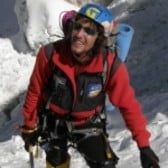
Sergey Kofanov
47 years, Australia
ALL YOU NEED TO KNOW TO CLIMB MOUNT DENALI SAFELY
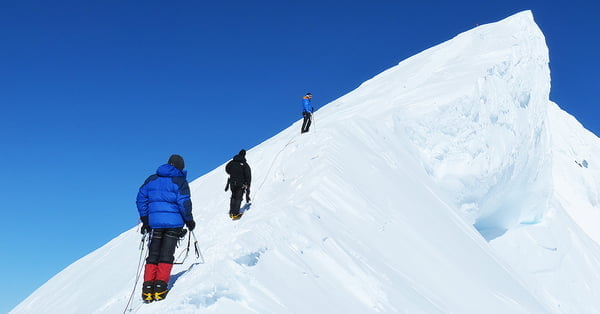
Mount Denali (6 195 m / 20 325 ft, Alaska Range) owes its popularity to the fact that it is the highest peak in North America. In addition, all the seven summits collectors go to Alaska to add this ascent to their collection. But besides belonging to the seven summits, Denali attracts people from all over the world because it is a unique adventure in the world combining snow, ice and polar sun. On one hand, the conditions here are not simple and tents are settled in the middle of deserted snowy expanses, surrounded only by glaciers with a lot of crevasses, the temperature can drop to minus 40 degrees... But on the other hand, it means communication with international climbers having a common goal. It means acquaintance with a clear American organization and the correct approach to all the details and nuances that can seriously affect the success of the entire expedition. In addition, only Denali combines organically the high-altitude expedition with well-developed National Park’s infrastructure.
I climbed Denali three times during different periods of the climbing seasons so I’ve got a total understanding what do you need for successful and safe climb. Once I climbed Denali during a recreational climb at the beginning of May (which is the very beginning of the season and I will never forget those minus 40 degrees). I climbed the Denali for the second time as a guide at the very end of the season, on Independence Day, on the 4th of July (my worst experience of glacier travelling ever since the number of crevasses were massive). Finally, the third time took place during the peak of the season, at the beginning of June (this trip was a real steal because we were lucky to get the only 10 days of good weather throughout the climbing season).
Before I proceed to the main part of this essay, I must warn you that the safest way to climb the Denali is by buying a guided tour from one of the travel agencies accredited by the National Park. If you are considering the possibility to climb the Denali solo or as part of a recreational expedition, then you put yourself into the risk zone unless you are a professional climber. In case you consider yourself a professional climber, this essay is probably not for you.

Denali Massif as it seen from the plane
Climbing the Denali as part of a commercial group is an expensive adventure. Normally, guided tours rates start from US $7500. There are just a handful of outdoor outfits accredited by the Denali National Park for the organization of guided tours, so that on one hand it simplifies your choice, and on the other hand it does not leave room for competition between other travel agencies. I know for sure that, on the market, there are private guides ready to take you to the top of the Denali for less money under a recreational climb. But I suggest that you to never fall into the temptation of saving money by hiring them. Perhaps 10-15 years ago you could still play this dishonest game, but in the modern world, every (more or less) decent mountain guide is easy traceable on the Internet and any ranger of the National Park will understand quickly your deception and will severely punish all its participants. So, think carefully as well as trying to save a thousand or two dollars, you are risking to be signed on the blacklist and never again have the opportunity to climb the Denali. There are cases (especially for the collectors of seven summits) when you have already used the same guide and you will want him to accompany you on your expedition. I assure you it's better to openly tell about it to the accredited tour operator and together find a compromise rather than risking and going breaking bad..
Denali is located just above the 63rd parallel, and this fact makes it the most northern 6000 meters of our planet. Bad news for you may be the fact that 6000 meters in Denali do not correspond to 6000 meters in the Himalayas, Andes or Kilimanjaro. The height seems to be the same, but it feels differently. The point here is that at the poles the air cushion of our atmosphere is much thinner than, let's say, at the equator. This is due to the centrifugal force generated by the rotation of our planet around its axis. But do not bother with the physics of this process. It is important to keep in mind that 6000 meters on the Denali is equivalent to approximately 7500 meters somewhere in the Himalayas. Of course, this is not a precise reference, but only related to how these vertical meters makes your body feel.
HOW TO CHOOSE THE RIGHT TOUR OPERATOR?
As I said before, there are just a handful of outdoor outfits, which are accredited by the Denali National Park. All of them are top professional and deserve your consideration. Their list can always be found on the official website of the National Park, as well as tons of other useful information about the ascent to Denali. Be careful, as the information on the official website is updated quite often.
WHAT IS THE BEST TIME TO CLIMB DENALI?
The climbing season on Denali is short enough. It lasts only about 3 months, starting from the middle of April and ending in the middle of July. Nobody will tell you for sure what time is the most successful, since every time interval has its pros and cons. For example, at the beginning of the season, the risk of falling into crevasse is significantly lower than at the end of the season, but in this case, you will have to deal with a temperature of 30-40 degrees below zero. At the end of the season it becomes much warmer, but the number of crevasses on the glacier increases proportionally to the temperature incrimination. Normally, at the beginning of the season the weather is slightly more stable than at the end, but trust me, weather is the factor that you should consider less. If you are not afraid of queues on the fixed ropes and overcrowded high camps, then choose the very middle of the season. It won't be so cold, and perhaps the glaciers will still be quite passable.
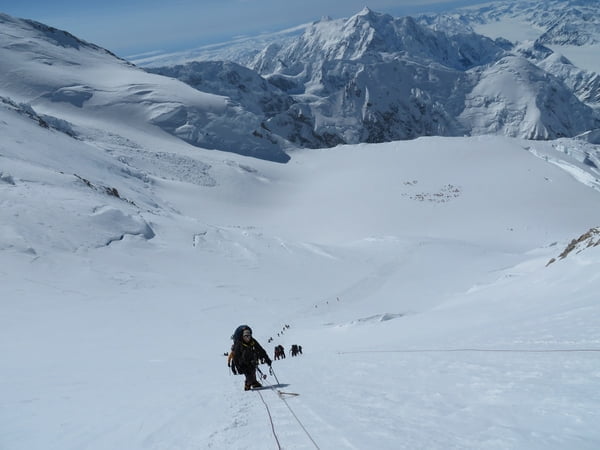
Climbers above Medical Camp
WHAT IS THE BEST ROUTE TO CLIMB DENALI?
In 90% of cases, people who come to Denali choose a route called West Buttress. This route is considered the least difficult of all existing routes on Denali, and importantly, it facilitates the organization of any rescue operations than on all others. Anyway, West Buttress requires basic climbing skills, as well as physical and psychological endurance of the climbers. The route starts from the Base Camp, located at an altitude of 7,200 feet in one of the southwestern branches of the Kahiltna Glacier. This is where small twin-engine planes land to bring mountaineers from Talkitna Airport. On the way from the Base Camp to the summit, there are five intermediate camps. The first two-thirds of the route pass through a relatively shallow glacier, except for a couple of steep slopes. The glacier is riddled with crevasses, so your group will have to be roped up all the way from the very beginning to the summit. Normally, rangers of the National Park mark the path on the glacier with the aid of special sticks. Starting from Camp Four (Medical Camp) the route line goes to the western rock buttress, but as a rule all the rocky areas are covered with snow and therefore are faced with crampons. There are some sites with narrow "snow knives" - the simultaneous movement of several groups on them is difficult. The buttress leads to the snowfields to Camp Five. Above Camp Five, an oblique traverse along a steep slope (up to 40 degrees) leads to the Col between the main (South) and the North Denali summits. On this site, the route is usually equipped with fixed snow bars with hinges and carbines, which are located at a distance of about 30 meters one from each other. Above the Col the route passes along the flat snowfields to the main summit. On the last part of the route you will have to overcome the slope by a steepness of up to 40 degrees, as well as a snow narrow summit ridge. The Denali top is a small snow patch marked with a special sign. During heavy snowfalls, the sign may be hiding beneath the snow, but anyway, the peak clearly stands out on the summit ridge and can't be confused with something else.
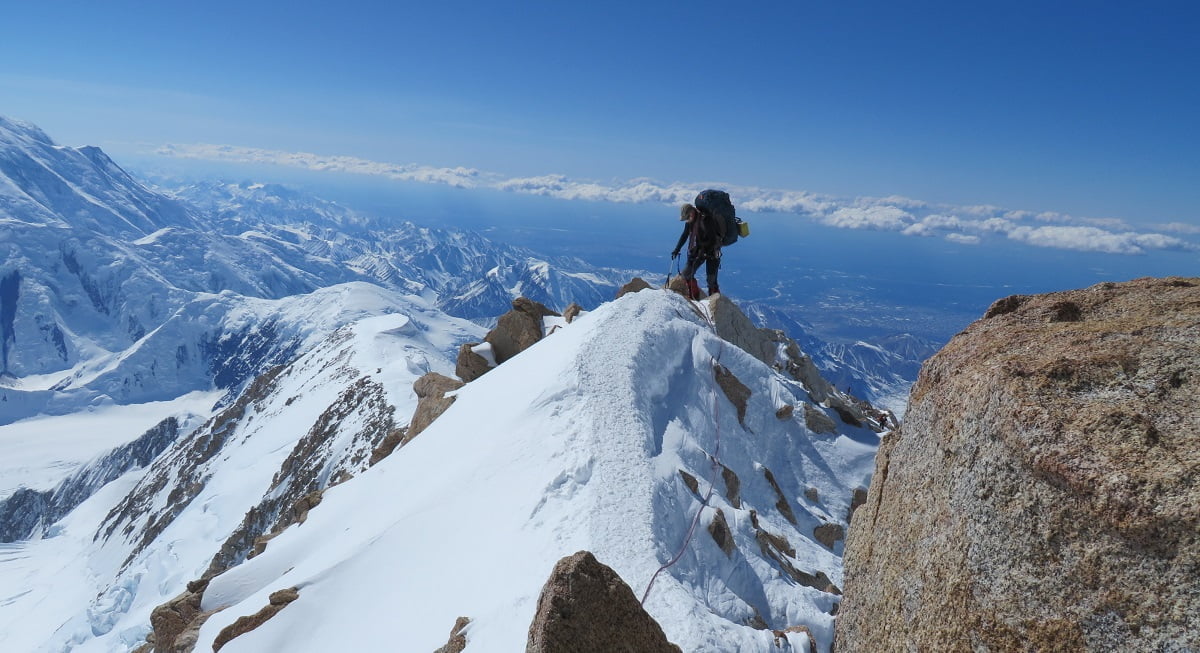
Approaching the snow knife on the West Buttress...
HOW MANY DAYS DO I NEED FOR A SUCCESSFUL AND SAFE CLIMB?
Climbing the Denali can take up to four weeks, so I would very much recommend that you get used to long expeditions before climbing. Two to three days of long ascents in the Alps and Cascade Mountains can certainly help, but they will not give you an understanding of how difficult it is for your body to be out of the normality and in such hard conditions of the Arctic winter for one month. If you have the opportunity, then try to go on a winter camping (i.e. a week ski trip with a tent). I assure you this type of experience will be very useful to you during the ascent.
WHAT KIND OF TRAINING AND EXPERIENCES I NEED BEFORE CLIMBING?
Despite the well-developed infrastructure of the Denali, this is clearly not the destination you should choose as your first high-altitude climb. Ideally, you will need to experience climbing up to 20,000 feet in order to understand how your body behaves under conditions of extremely thin air. If you aren't used to dealing with high-altitude sickness, then, at some point, your body may simply stop working properly. On Denali, every year there are many rescue operations to evacuate climbers facing High-Altitude Cerebral Edema (HACE). Overall, I would recommend that you first try yourself at Mount Rainier or any other peak at least 14,000 feet high, or join one of the climbing course that outdoor outfits manage in the Mount Denali area.
The minimum climbing skills that are required before climbing are glacier travel and glacier rescue, that means you should be confident in using crampons, doing self-arrest and crevasse rescue.
Having an experience of winter camping is also very desirable, because on Denali you will have to face the same exact cold encountered by climbers at 8000m in the Himalayas.
Keep in mind that there are no porters on Denali, and you will have to carry all your expedition cargo yourself. This means that for at least a week for 6-8 hours a day you will travel with a backpack weighing up to 25 kilograms on your shoulders and with sledges weighing up to 30 kilograms. If you do not feel confident about it, then it is better to leave your expedition for the next year and spend it on training.
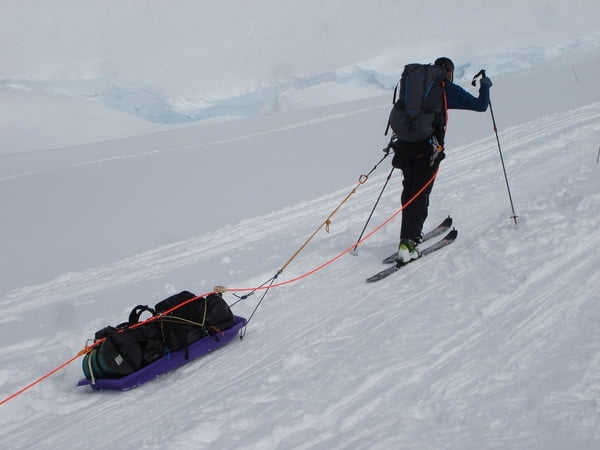
When I say "no porters" it means no porters at all...
WHAT EQUIPMENT IS NEEDED?
I can tell you with full responsibility that your health and life will depend on the quality of your equipment, so take care of the selection of equipment as well as you can. On the mountainplanet.com site I created a list of equipment required to climb the Denali with examples of those models that I recommend to you, and attached it to the profile by describing the route West Buttress. You can get closer to it, and also ask me your questions under this link (you need to be logged in to see the entire list) - https://mountainplanet.com/mountaineering/route-denali-west-buttress/gearlist.
WHAT ABOUT THE RED TAPE?
Denali is located on the territory of the National Park, therefore, all climbers planning to climb Denali are required to register with the ranger’s station located in the city of Talkitna, at least 60 days before the beginning of the expedition. Registration and payment for permission can be made online with a credit card on the official Denali National Park website. Alpinists who have already attempted to climb Denali at least once since 1995 are eligible for an exception to this rule and can be registered seven days before the beginning of the expedition (special conditions apply, see the official website of the National Park). The number of permissions Denali National Park gives during the climbing season is relatively small, so you are unlikely to be lucky enough to find a free entry just before the beginning of the season. Normally, people plan this climb six to eight months in advance, in order to guarantee their climb to Denali.
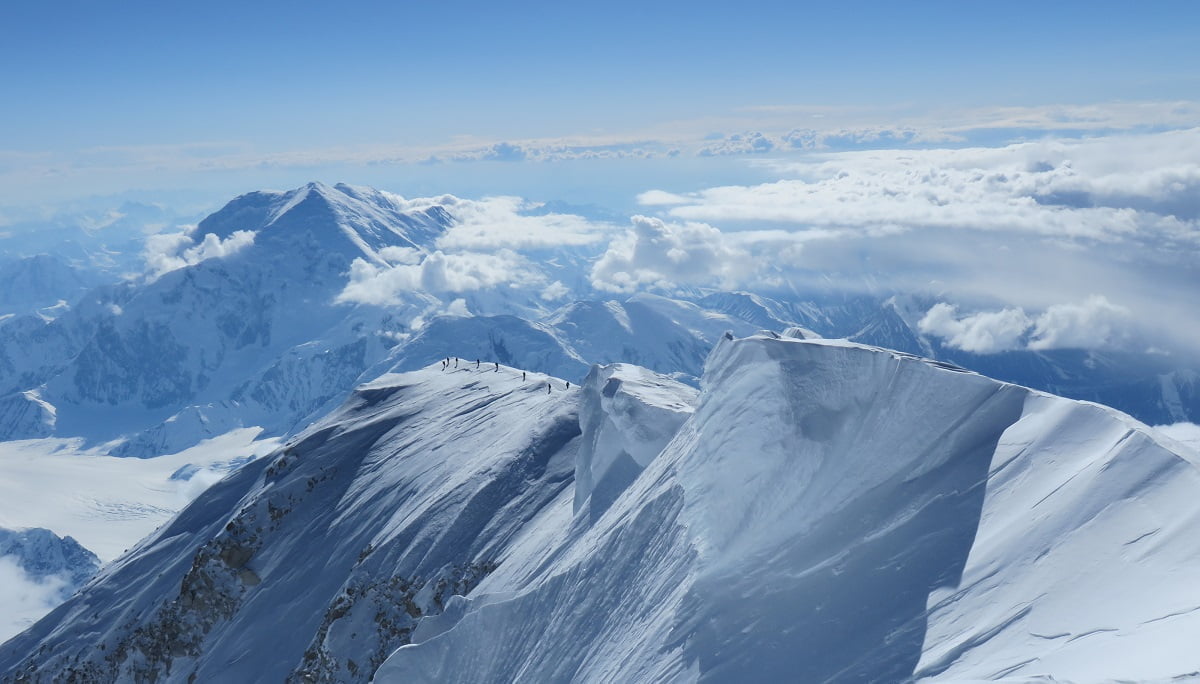
Denali Summit Ridge
FAQ
Skis or snowshoes?
Ideally, all members of the expedition should use either skis or snowshoes. If someone in your group is skiing and someone is snowshoeing, then this can lead to conflicts in the choice of pace or the way to travel (especially in the case of the descent). Absolutely do not go for skis, if you don't have any experience with them.
Is it possible to climb Denali solo or unguided?
Every year dozens of climbers make unguided climbs to the top of Denali, so of course this is possible. However, in most cases all these people are professional mountaineers, or have a solid background of serious ascents. So, if you do not rank yourself in any of these groups, you better go for guided climbs.
Do cell phones work?
The site of the National Park says there is signal on some sections of the route. Personally, I saw climbers use them just a couple of times. I prefer to use the satellite phone, since it weighs not much more than a cell phone, but it works at any point of the route.
Where can I find information about the registration and authorisation processes?
All information is available on the official website of the Denali National Park.
You can ask your questions in the comments to this article and I will be happy to answer them and add these answers to the Frequently Asked Questions (FAQ) section.

